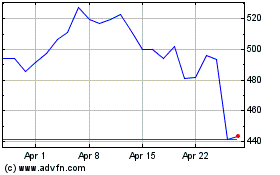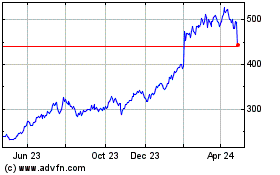By Newley Purnell
NEW DELHI -- In India, viral fake news is lighting up Facebook
Inc.'s WhatsApp messaging app as the world's biggest democracy
prepares for national elections in the coming weeks.
Efforts by WhatsApp and the government to stop the spread of
misinformation are having little effect, according to fact-checking
groups and analysts.
That is a challenge for Facebook, as well as policy makers and
voters grappling with digital falsehoods in India, a country of 1.3
billion people where mobile internet access has exploded in recent
years.
It also provides a unique window on how Facebook Chief Executive
Mark Zuckerberg's surprising strategic shift from public postings
to private messaging could play out around the world. Mr.
Zuckerberg said in March that Facebook would move to a model
favoring encrypted group chats like those on WhatsApp, which is
popular in emerging economies including Brazil and Indonesia.
India is WhatsApp's biggest market. Research firm Counterpoint
estimates it has 300 million users, making it bigger here than
Facebook. WhatsApp hasn't released user figures since February
2017, when it said it had 200 million users in India. Since then,
plummeting prices for mobile data and inexpensive smartphones have
made WhatsApp the default digital town square in a country with
deep societal divides.
India's political parties often employ WhatsApp to blast
tailored political messages to tens of thousands of WhatsApp groups
they have created. The groups are often organized by caste, income
level and religion, said Shivam Shankar Singh, a University of
Michigan graduate who worked as a data consultant for the country's
ruling party. He resigned last year, citing the party's spreading
of fake news as a reason.
"India is now the world's cheapest country to spread fake news,"
said Counterpoint analyst Tarun Pathak. Many of the new users
getting online are in rural areas, with limited digital literacy,
and are using mobile phones that cost as little as $20, he
said.
Among the WhatsApp messages that have taken off in recent weeks
is footage from a videogame falsely purporting to show Indian
warplanes blowing up a building across rival Pakistan's border.
Other images have shown people who died in a heat wave passed off
as dead militants.
WhatsApp users have also shared messages falsely claiming that
the father of a captured Indian Air Force pilot had joined an
opposition political party. Others are more prosaic but potentially
problematic, such as a graphic showing inaccurate dates for the
coming polls.
"In the last year misinformation has migrated from Facebook to
WhatsApp, " said Govindraj Ethiraj, a journalist and founder of
popular fact-checking website Boom, which Facebook itself has
enlisted as a partner to debunk bogus claims that go viral.
Last year, Mr. Ethiraj's group received about one dozen tips a
day from volunteers highlighting hoaxes coming from WhatsApp. They
now number in the hundreds each day, he said, with WhatsApp's
opacity and ubiquity aiding their spread.
WhatsApp, which Facebook acquired in 2014 for $22 billion, has
tweaked its app to try to prevent false news from going viral. It
maintains that the app isn't meant for the bulk sending of
messages.
"The WhatsApp team has made substantial changes to the platform
specific to India," said Samidh Chakrabarti, Facebook's director of
product management for civic integrity. He referred questions about
the prevalence of false news on the platform to WhatsApp.
A person familiar with WhatsApp's thinking said it is monitoring
coordinated abuse as elections approach, and that the company
considers false news a challenge to all technology platforms, not
solely WhatsApp. The firm says it removes more than two million
suspicious accounts globally a month, though it doesn't break out
the number in India.
Some 64% of Indians say they encounter fake news, higher than
the global average of 57%, according to a Microsoft Corp. survey.
Meanwhile, 52% of people surveyed in the South Asian nation say
they get news from WhatsApp, significantly higher than most
European countries and the U.S., according to a March report from
the Reuters Institute for the Study of Journalism and the
University of Oxford in England.
Conventional text messages are typically sent between
individuals or small groups, incur a small cost to senders, and can
be accessed when needed by authorities. WhatsApp allows groups of
up to 256 people to easily exchange words, videos and images for
just fractions of a penny, or for free if connected to Wi-Fi. The
content is encrypted, unreadable in transit, and cannot be seen by
authorities, or WhatsApp itself, the company says.
With a few clicks of a button, WhatsApp users can forward
content to more than 1,200 people. However, unlike when material is
posted to Facebook or Twitter Inc., the origin of a WhatsApp
message can become unclear once it has been forwarded.
After more than 20 people were killed last year in India in mob
violence following false rumors spread through the app, WhatsApp
limited the number of groups to which messages can be forwarded to
five. It also labeled forwarded messages as such and has made users
click extra buttons to send them. The company has also launched
offline educational campaigns -- such as one called "Share joy, not
rumors" -- to dissuade users from sharing misinformation.
Analysts say WhatsApp's educational and technical efforts don't
appear to be working. "I don't see any change," said Pratik Sinha,
co-founder of fact-checking website Alt News.
Even the fact-checking groups' work has limited impact, said
Vidya Narayanan, a researcher at the Oxford Internet Institute who
has studied misinformation in India. That is because their
corrections to viral messages typically aren't seen until days
after fake news has been widely disseminated and absorbed by
citizens.
Meanwhile, the Indian government has proposed guidelines that
would force WhatsApp to break its encryption to hunt down those who
send objectionable content. WhatsApp says it is committed to
maintaining encryption to protect users' privacy.
Write to Newley Purnell at newley.purnell@wsj.com
(END) Dow Jones Newswires
March 31, 2019 14:18 ET (18:18 GMT)
Copyright (c) 2019 Dow Jones & Company, Inc.
Meta Platforms (NASDAQ:META)
Historical Stock Chart
From Mar 2024 to Apr 2024

Meta Platforms (NASDAQ:META)
Historical Stock Chart
From Apr 2023 to Apr 2024
